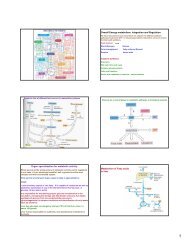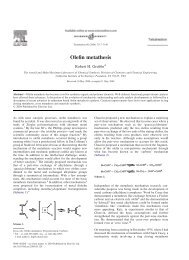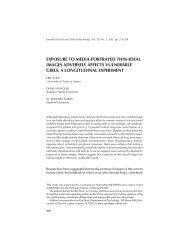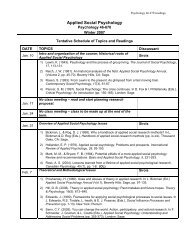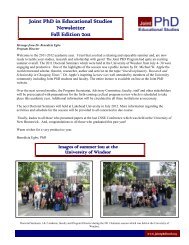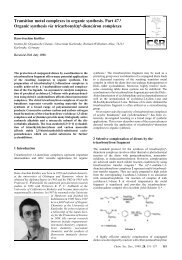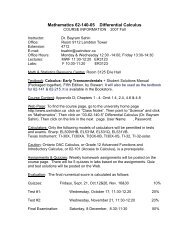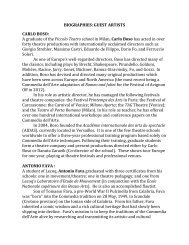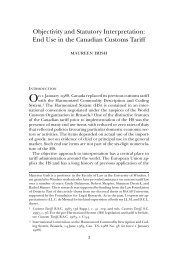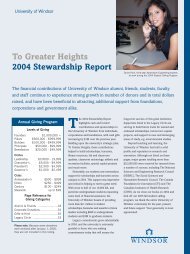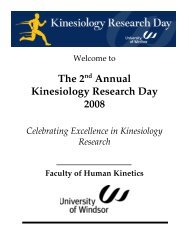Photoinduced Reactions of Metal Carbenes in Organic Synthesis
Photoinduced Reactions of Metal Carbenes in Organic Synthesis
Photoinduced Reactions of Metal Carbenes in Organic Synthesis
You also want an ePaper? Increase the reach of your titles
YUMPU automatically turns print PDFs into web optimized ePapers that Google loves.
Topics Organomet Chem (2004) 13: 157–201<br />
DOI 10.1007/b98765<br />
© Spr<strong>in</strong>ger-Verlag Berl<strong>in</strong> Heidelberg 2004<br />
<strong>Photo<strong>in</strong>duced</strong> <strong>Reactions</strong> <strong>of</strong> <strong>Metal</strong> <strong>Carbenes</strong> <strong>in</strong> <strong>Organic</strong><br />
<strong>Synthesis</strong><br />
Louis S. Hegedus (✉)<br />
Department <strong>of</strong> Chemistry, Colorado State University, Fort Coll<strong>in</strong>s, CO 80523-1872, USA<br />
hegedus@lamar.colostate.edu<br />
1 Introduction . . . . . . . . . . . . . . . . . . . . . . . . . . . . . . . . . 158<br />
2 <strong>Photo<strong>in</strong>duced</strong> <strong>Reactions</strong> <strong>of</strong> Fischer Carbene Complexes . . . . . . . . . 159<br />
2.1 Involv<strong>in</strong>g CO Insertion . . . . . . . . . . . . . . . . . . . . . . . . . . . 159<br />
2.1.1 Cycloaddition <strong>Reactions</strong> . . . . . . . . . . . . . . . . . . . . . . . . . . 159<br />
2.1.1.1 With Im<strong>in</strong>es to Form b-Lactams . . . . . . . . . . . . . . . . . . . . . . 159<br />
2.1.1.2 With Olef<strong>in</strong>s to Give Cyclobutanones . . . . . . . . . . . . . . . . . . . . 168<br />
2.1.1.3 With Aldehydes to Give b-Lactones . . . . . . . . . . . . . . . . . . . . . 177<br />
2.1.1.4 With Azoarenes to Give Diazetid<strong>in</strong>ones . . . . . . . . . . . . . . . . . . 178<br />
2.1.1.5 Photochemical Benzannulation <strong>Reactions</strong> . . . . . . . . . . . . . . . . . 178<br />
2.1.2 Nucleophilic Attack . . . . . . . . . . . . . . . . . . . . . . . . . . . . . 182<br />
2.1.2.1 By Alcohols to Give Esters . . . . . . . . . . . . . . . . . . . . . . . . . . 182<br />
2.1.2.2 By Am<strong>in</strong>o Acids to Give Peptides . . . . . . . . . . . . . . . . . . . . . . 187<br />
2.1.2.3 By Stabilized Ylides to Produce Captodative Allenes . . . . . . . . . . . 189<br />
2.1.2.4 By Arenes: Intramolecular Friedel–Crafts Arene Acylation . . . . . . . . 189<br />
2.1.2.5 By Tertiary Allylic Am<strong>in</strong>es: Zwitterionic Aza-Cope Rearrangement . . . 190<br />
2.2 Photodriven <strong>Reactions</strong> <strong>of</strong> Fischer <strong>Carbenes</strong> Not Involv<strong>in</strong>g CO Insertion . 191<br />
2.2.1 Nucleophilic Addition/Elim<strong>in</strong>ation at the Carbene Carbon . . . . . . . . 191<br />
2.2.2 Cyclopropanation and Other Cycloadditions . . . . . . . . . . . . . . . 192<br />
2.2.3 Acyl Migration . . . . . . . . . . . . . . . . . . . . . . . . . . . . . . . . 197<br />
3 Conclusions . . . . . . . . . . . . . . . . . . . . . . . . . . . . . . . . . 198<br />
References . . . . . . . . . . . . . . . . . . . . . . . . . . . . . . . . . . . . . . . 198<br />
Abstract The photo<strong>in</strong>duced reactions <strong>of</strong> metal carbene complexes, particularly Group 6<br />
Fischer carbenes, are comprehensively presented <strong>in</strong> this chapter with a complete list<strong>in</strong>g <strong>of</strong><br />
published examples. A majority <strong>of</strong> these processes <strong>in</strong>volve CO <strong>in</strong>sertion to produce species<br />
that have ketene-like reactivity. Cycloaddition reactions presented <strong>in</strong>clude reaction with<br />
im<strong>in</strong>es to form b-lactams, with alkenes to form cyclobutanones, with aldehydes to form<br />
b-lactones, and with azoarenes to form diazetid<strong>in</strong>ones. <strong>Photo<strong>in</strong>duced</strong> benzannulation<br />
processes are <strong>in</strong>cluded. <strong>Reactions</strong> <strong>in</strong>volv<strong>in</strong>g nucleophilic attack to form esters, am<strong>in</strong>o acids,<br />
peptides, allenes, acylated arenes, and aza-Cope rearrangement products are detailed. A<br />
number <strong>of</strong> photo<strong>in</strong>duced reactions <strong>of</strong> carbenes do not <strong>in</strong>volve CO <strong>in</strong>sertion. These <strong>in</strong>clude<br />
reactions with sulfur ylides and sulfilim<strong>in</strong>es, cyclopropanation, 1,3-dipolar cycloadditions,<br />
and acyl migrations.<br />
Keywords <strong>Metal</strong> carbenes · Photochemical reactions · <strong>Metal</strong>-ketene complexes
158 L. S. Hegedus<br />
Abbreviations<br />
Bn Benzyl<br />
Cbz Benzyloxycarbonyl<br />
DMAP Dimethylam<strong>in</strong>opyrid<strong>in</strong>e<br />
HOMO Highest occupied molecular orbital<br />
LF Ligand field<br />
LUMO Lowest unoccupied molecular orbital<br />
MLCT <strong>Metal</strong>-to-ligand charge transfer<br />
PMB Para-methoxybenzyl<br />
PMP Para-methoxyphenyl<br />
PPTS Pyrid<strong>in</strong>ium para-toluenesulfonate<br />
tBOC t-Butyloxycarbonyl<br />
1<br />
Introduction<br />
Although many transition metals form carbene complexes, only Group 6 (Cr,<br />
Mo, W) heteroatom-stabilized Fischer carbenes <strong>of</strong> the type<br />
have been extensively studied as reagents for organic synthesis (with the obvious<br />
exception <strong>of</strong> olef<strong>in</strong> metathesis chemistry [1]). Synthetically useful photochemical<br />
reactions have largely been restricted to Cr and Mo carbene complexes, thus this<br />
chapter will deal primarily with the chemistry <strong>of</strong> these. S<strong>in</strong>ce photochemical reactions<br />
<strong>in</strong>volve excited-state chemistry at some stage, the electronic (UV-VIS)<br />
spectra <strong>of</strong> Fischer carbenes are central to a consideration <strong>of</strong> this chemistry.<br />
The visible spectra <strong>of</strong> Fischer carbene complexes consist <strong>of</strong> a very weak band<br />
above 500 nm, assigned to a sp<strong>in</strong>-forbidden metal-to-ligand charge transfer band<br />
(MLCT), a moderately <strong>in</strong>tense band between 350 and 450 nm assigned as a sp<strong>in</strong>allowed<br />
MLCT, and a weaker band at 300–350 nm assigned as a ligand field (LF)<br />
transition [2]. A lower energy LF band is usually masked by the more <strong>in</strong>tense<br />
MLCT, although it has been observed <strong>in</strong> some nonheteroatom-stabilized carbene<br />
complexes [3]. The HOMO is metal dp–pp centered while the LUMO is carbenecarbon<br />
pp centered [4]. As a result, irradiation <strong>in</strong>to the MLCT band should lead<br />
to charge transfer from the metal to the ligand, a formal oxidation <strong>of</strong> the metal.<br />
In attempts to understand the photochemical reactions <strong>of</strong> Fischer carbene<br />
complexes, several matrix isolation and flash photolysis studies have been conducted<br />
us<strong>in</strong>g both Cr and W (but not Mo) complexes [5–11].Although the complexes<br />
studied and conditions used varied, several general conclusions were<br />
drawn:<br />
1. For chromium alkoxycarbene complexes the MLCT and the lowest energy<br />
LF bands overlap. Irradiation at l>385 nm led to anti–syn isomerization
<strong>Photo<strong>in</strong>duced</strong> <strong>Reactions</strong> <strong>of</strong> <strong>Metal</strong> <strong>Carbenes</strong> <strong>in</strong> <strong>Organic</strong> <strong>Synthesis</strong> 159<br />
<strong>of</strong> the OMe group and 30% loss <strong>of</strong> CO. Loss <strong>of</strong> CO was even observed at<br />
l>400 nm [9].<br />
2. Tungsten alkoxycarbene complexes underwent similar anti–syn rearrangements<br />
but were much less prone to undergo CO loss [5–10].<br />
3. No CO-<strong>in</strong>sertion products (metal-ketene complexes) were observed, even<br />
when specifically sought [9, 10].<br />
These results suggest that there should be little useful organic chemistry result<strong>in</strong>g<br />
from photo<strong>in</strong>duced reactions <strong>of</strong> Fischer carbene complexes. However,<br />
this was shown not to be the case.<br />
In studies designed to develop new approaches to b-lactams,Michael McGuire,<br />
then a graduate student <strong>in</strong> the author’s research group, discovered that photolysis<br />
<strong>of</strong> a range <strong>of</strong> Cr Fischer carbene complexes with visible light through Pyrex<br />
produced a short-lived species that had ketene-like reactivity [12]. Subsequent<br />
studies [13] suggested that irradiation promoted reversible <strong>in</strong>sertion <strong>of</strong> one <strong>of</strong> the<br />
four cis-COs <strong>in</strong>to the metal-carbene-carbon double bond,produc<strong>in</strong>g a short-lived<br />
metallacyclopropanone-metal-ketene complex (Eq. 1). In the absence <strong>of</strong> reactive<br />
substrates, rapid de<strong>in</strong>sertion occurred, regenerat<strong>in</strong>g the carbene complex.<br />
Several stable Group 6 metal-ketene complexes are known [14], and photodriven<br />
<strong>in</strong>sertion <strong>of</strong> CO <strong>in</strong>to a tungsten-carbyne-carbon triple bond has been<br />
demonstrated [15]. In addition, thermal decomposition <strong>of</strong> the nonheteroatomstabilized<br />
carbene complexes (CO) 5M=CPh 2 (M=Cr,W) produces diphenylketene<br />
[16]. Thus, the <strong>in</strong>termediacy <strong>of</strong> transient metal-ketene complexes <strong>in</strong> the<br />
photodriven reactions <strong>of</strong> Group 6 Fischer carbenes seems at least possible.<br />
2<br />
<strong>Photo<strong>in</strong>duced</strong> <strong>Reactions</strong> <strong>of</strong> Fischer Carbene Complexes<br />
2.1<br />
Involv<strong>in</strong>g CO Insertion<br />
2.1.1<br />
Cycloaddition <strong>Reactions</strong><br />
2.1.1.1<br />
With Im<strong>in</strong>es to Form bb-Lactams<br />
The reaction <strong>of</strong> ketenes (usually formed from treatment <strong>of</strong> acid chlorides with<br />
tertiary am<strong>in</strong>es) with im<strong>in</strong>es is a classic way to form b-lactams [17, 18].Although<br />
widely used, it suffers limitations <strong>in</strong> scope and efficiency, s<strong>in</strong>ce free ketenes are<br />
(1)
160 L. S. Hegedus<br />
highly reactive, and prone to dimerization and multiple <strong>in</strong>corporations <strong>in</strong>to<br />
products.Whatever the nature <strong>of</strong> the photogenerated species from Fischer carbene<br />
complexes, free ketenes are not produced, and these by-products are not<br />
expected.<br />
Photolysis <strong>of</strong> chromium alkoxycarbene complexes with a wide range <strong>of</strong><br />
acyclic im<strong>in</strong>es <strong>of</strong> aromatic aldehydes produced b-lactams <strong>in</strong> good to excellent<br />
yield (Table 1). The reaction was highly diastereoselective <strong>in</strong> virtually all cases,<br />
giv<strong>in</strong>g the relative stereochemistry shown. Cyclic and heterocyclic im<strong>in</strong>es<br />
were similarly reactive, aga<strong>in</strong> produc<strong>in</strong>g s<strong>in</strong>gle diastereoisomers (Table 2). Of<br />
particular note is the clean conversion <strong>of</strong> protected imidazol<strong>in</strong>es to azapenams.<br />
The transformation us<strong>in</strong>g ketenes generated from acid chlorides does<br />
not take place [27]. Bis-carbene complexes underwent photoreaction with<br />
imidazol<strong>in</strong>es to give bis-azapenams as 1:1 mixtures <strong>of</strong> diastereoisomers. (The<br />
relative configuration <strong>of</strong> each azapenam had the two heteroatoms trans, as<br />
expected, but a 1:1 mixture <strong>of</strong> [(R,R)(S,S)] and (R,S) diastereomers resulted)<br />
Table 1 Reaction <strong>of</strong> chromium alkoxycarbenes with acyclic aryl aldim<strong>in</strong>es<br />
CH 2OMe<br />
71
<strong>Photo<strong>in</strong>duced</strong> <strong>Reactions</strong> <strong>of</strong> <strong>Metal</strong> <strong>Carbenes</strong> <strong>in</strong> <strong>Organic</strong> <strong>Synthesis</strong> 161<br />
Table 2 Reaction <strong>of</strong> chromium alkoxycarbenes with cyclic im<strong>in</strong>es
162 L. S. Hegedus<br />
Table 2 (cont<strong>in</strong>ued)<br />
(Eq. 2) [28, 29]. Bis-carbenes l<strong>in</strong>ked through the alkyl (rather than alkoxy)<br />
groups reacted similarly but <strong>in</strong> lower yields [30].<br />
(2)<br />
A few heterocyclic im<strong>in</strong>es reacted poorly if at all with chromium alkoxycarbene<br />
complexes. Oxaz<strong>in</strong>es required the use <strong>of</strong> the more reactive (and less stable)<br />
molybdenum alkoxycarbenes, produc<strong>in</strong>g oxacephams <strong>in</strong> ≈40% yield. Oxazol<strong>in</strong>es<br />
gave low yields (≈12%) <strong>of</strong> the oxapenam system, along with similar<br />
amounts <strong>of</strong> oxaz<strong>in</strong>one, result<strong>in</strong>g from <strong>in</strong>corporation <strong>of</strong> two equivalents <strong>of</strong><br />
ketene (Eq. 3) [20].<br />
(3)
<strong>Photo<strong>in</strong>duced</strong> <strong>Reactions</strong> <strong>of</strong> <strong>Metal</strong> <strong>Carbenes</strong> <strong>in</strong> <strong>Organic</strong> <strong>Synthesis</strong> 163<br />
CBz-protected benzimidazole gave primarily oxaz<strong>in</strong>one [31], while 3H-<strong>in</strong>doles<br />
<strong>in</strong>corporated two equivalents <strong>of</strong> im<strong>in</strong>e (Eq. 4) [32]. In these cases it appears that<br />
the <strong>in</strong>itially formed zwitterionic ketene–im<strong>in</strong>e adduct could not close, and reacted<br />
with additional photoactivated carbene or substrate.<br />
Other miscellaneous im<strong>in</strong>es that underwent photoreaction with chromium<br />
alkoxycarbenes <strong>in</strong>clude im<strong>in</strong>odithiocarbonates [33], the mono-N-phenyl im<strong>in</strong>e<br />
<strong>of</strong> benzil and the bis-N-phenyl im<strong>in</strong>e <strong>of</strong> aceto<strong>in</strong> [20]. By prepar<strong>in</strong>g the chromium<br />
carbene complex from 13 CO-labeled chromium hexacarbonyl, b-lactams<br />
with two adjacent 13 C labels were synthesized [34].<br />
Induction <strong>of</strong> asymmetry <strong>in</strong>to the b-lactam-form<strong>in</strong>g process was <strong>in</strong>efficient<br />
with acyclic im<strong>in</strong>es hav<strong>in</strong>g chiral groups on the nitrogen [19] but efficient with<br />
rigid, cyclic chiral im<strong>in</strong>es (Table 3). One <strong>of</strong> these was used as a chiral template<br />
to produce highly functionalized quaternary systems (Eq. 5) [34].<br />
The mechanism <strong>of</strong> the classic ketene–im<strong>in</strong>e reaction to form b-lactams [17, 18]<br />
is thought to <strong>in</strong>volve perpendicular attack <strong>of</strong> the im<strong>in</strong>e nitrogen on the ketene<br />
carbonyl carbon from the side <strong>of</strong> the sterically smaller <strong>of</strong> the two groups,<br />
followed by conrotatory closure <strong>of</strong> the zwitterionic <strong>in</strong>termediate (Eq. 6). This<br />
(4)<br />
(5)<br />
(6)
164 L. S. Hegedus<br />
Table 3 Reaction <strong>of</strong> chromium alkoxycarbenes with chiral heterocyclic im<strong>in</strong>es<br />
places the large substituent <strong>of</strong> the ketene cis to the anti-substituent <strong>of</strong> the im<strong>in</strong>e.<br />
In all the cases cited above, the observed stereochemistry was exactly opposite<br />
that expected on these steric grounds. Initially, this difference was thought to<br />
be due to the presence <strong>of</strong> the metal dur<strong>in</strong>g the cycloadditions, bias<strong>in</strong>g the<br />
process to produce the contrasteric product. However, subsequent considerations<br />
[37], supported by theoretical calculations relat<strong>in</strong>g the closure step <strong>of</strong><br />
b-lactam formation to the electronic bias observed (“torquoselectivity”) <strong>in</strong> the<br />
r<strong>in</strong>g open<strong>in</strong>g <strong>of</strong> cyclobutenes bear<strong>in</strong>g heteroatom substituents [38], suggested<br />
that the observed stereoselectivity was due to the presence <strong>of</strong> the donor methoxy<br />
group on the ketene. This greatly lowers the energy for closure <strong>of</strong> the<br />
zwitterion result<strong>in</strong>g from attack over the large R group, from the face opposite<br />
the donor groups, lead<strong>in</strong>g to the contrasteric product (Eq. 7).
<strong>Photo<strong>in</strong>duced</strong> <strong>Reactions</strong> <strong>of</strong> <strong>Metal</strong> <strong>Carbenes</strong> <strong>in</strong> <strong>Organic</strong> <strong>Synthesis</strong> 165<br />
Chromium am<strong>in</strong>ocarbenes [39] are readily available from the reaction <strong>of</strong><br />
K 2Cr(CO) 5 with im<strong>in</strong>ium chlorides [40] or amides and trimethylsilyl chloride<br />
[41]. Those from formamides (H on carbene carbon) readily underwent photoreaction<br />
with a variety <strong>of</strong> im<strong>in</strong>es to produce b-lactams, while those hav<strong>in</strong>g<br />
R-groups (e.g., Me) on the carbene carbon produced little or no b-lactam products<br />
[13]. The dibenzylam<strong>in</strong>ocarbene complex underwent reaction with high<br />
diastereoselectivity (Table 4). As previously observed, cyclic, optically active<br />
im<strong>in</strong>es produced b-lactams with high enantioselectivity, while acyclic, optically<br />
active im<strong>in</strong>es <strong>in</strong>duced little asymmetry.An <strong>in</strong>tramolecular version produced an<br />
unusual anti-Bredt lactam rather than the expected b-lactam (Eq. 8) [44].<br />
With optically active formamide-derived am<strong>in</strong>ocarbene complexes high<br />
enantioselectivity was observed <strong>in</strong> most cases (Table 5). This chemistry was<br />
used <strong>in</strong> the synthesis <strong>of</strong> 1-carbacephalath<strong>in</strong> and 3-ANA precursors (Eq. 9) [48],<br />
as well as the synthesis <strong>of</strong> a,a¢-disubstituted am<strong>in</strong>o acids (Scheme 1) [49].<br />
Although the photodriven reactions <strong>of</strong> chromium carbene complexes with<br />
im<strong>in</strong>es superficially resemble those <strong>of</strong> free ketenes, there are major differences.<br />
The optically active oxazolid<strong>in</strong>e carbene (Table 5) gave excellent yields and<br />
high ee values when allowed to react with imidates, oxaz<strong>in</strong>es, thiaz<strong>in</strong>es, and<br />
(7)<br />
(8)<br />
(9)
166 L. S. Hegedus<br />
Table 4 Reaction <strong>of</strong> chromium am<strong>in</strong>ocarbenes with im<strong>in</strong>es
<strong>Photo<strong>in</strong>duced</strong> <strong>Reactions</strong> <strong>of</strong> <strong>Metal</strong> <strong>Carbenes</strong> <strong>in</strong> <strong>Organic</strong> <strong>Synthesis</strong> 167<br />
Table 5 Reaction <strong>of</strong> optically active am<strong>in</strong>ocarbenes with im<strong>in</strong>es<br />
aliphatic im<strong>in</strong>es, but modest yields <strong>of</strong> mixtures <strong>of</strong> cis and trans isomers with<br />
aryl or a,b-unsaturated im<strong>in</strong>es [50]. In contrast, the correspond<strong>in</strong>g oxazolid<strong>in</strong>one<br />
ketene (from the acid chloride [51]) gave excellent yields and ee values<br />
with aryl and a,b-unsaturated im<strong>in</strong>es but very low yields <strong>of</strong> b-lactams with<br />
other im<strong>in</strong>es. Clearly chromium is <strong>in</strong>fluenc<strong>in</strong>g the outcome <strong>of</strong> the process.<br />
Pyrrolocarbenes produced low yields <strong>of</strong> b-lactams <strong>in</strong> photodriven reactions<br />
with im<strong>in</strong>es [52], while o-acylimidatocarbene complexes gave a mixture <strong>of</strong><br />
compounds with b-lactams be<strong>in</strong>g m<strong>in</strong>or components [53].
168 L. S. Hegedus<br />
Scheme 1<br />
2.1.1.2<br />
With Olef<strong>in</strong>s to Give Cyclobutanones<br />
The first report <strong>of</strong> the reaction <strong>of</strong> a chromium alkoxycarbene with an alkene to<br />
give a cyclobutanone came <strong>in</strong> 1974 [54], when it was reported that treatment <strong>of</strong><br />
the (phenyl)(methoxy) chromium carbene complex with N-v<strong>in</strong>yl pyrrolid<strong>in</strong>one<br />
under 150 atm <strong>of</strong> CO pressure produced the correspond<strong>in</strong>g cyclobutanone,<br />
presumably via the ketene or ketene complex produced by pressure-driven<br />
<strong>in</strong>sertion <strong>of</strong> CO <strong>in</strong>to the metal-carbene-carbon bond. It wasn’t until 1989<br />
that the photodriven version <strong>of</strong> this process was reported [55]. Monosubstituted,<br />
electron-rich alkenes underwent photochemical reaction with chromium<br />
alkoxycarbenes to produce cyclobutanones <strong>in</strong> fair to good yield and with<br />
high stereoselectivity for the more h<strong>in</strong>dered cyclobutanone (Table 6) [56], the<br />
same selectivity as that observed with free ketenes [57]. Di- and trisubstituted<br />
alkenes were somewhat less efficient (Table 7) [56], while dienes underwent<br />
cycloaddition to one <strong>of</strong> the two alkenes (Table 8) [56]. Intramolecular versions<br />
were also efficient to form five- and six-membered r<strong>in</strong>gs, but larger r<strong>in</strong>gs failed<br />
to form and tethered alkynes gave complex mixtures <strong>of</strong> unidentified products<br />
(Table 9) [56].<br />
Alkoxycarbene complexes with unsaturation <strong>in</strong> the alkyl side cha<strong>in</strong> rather<br />
than the alkoxy cha<strong>in</strong> underwent similar <strong>in</strong>tramolecular photoreactions<br />
(Eqs. 10 and 11) [60]. Cyclopropyl carbene complexes underwent a facile v<strong>in</strong>ylcyclopropane<br />
rearrangement, presumably from the metal-bound ketene <strong>in</strong>termediate<br />
(Eqs. 12 and 13) [61].A cycloheptatriene carbene complex underwent<br />
a related [6+2] cycloaddition (Eq. 14) [62].
<strong>Photo<strong>in</strong>duced</strong> <strong>Reactions</strong> <strong>of</strong> <strong>Metal</strong> <strong>Carbenes</strong> <strong>in</strong> <strong>Organic</strong> <strong>Synthesis</strong> 169<br />
Table 6 Reaction <strong>of</strong> alkoxycarbenes with monosubstituted alkenes<br />
(10)
170 L. S. Hegedus<br />
Table 7 Reaction <strong>of</strong> alkoxycarbenes with polysubstituted alkenes<br />
Table 8 Reaction <strong>of</strong> alkoxycarbenes with cyclic dienes<br />
R=R¢=OMe�
<strong>Photo<strong>in</strong>duced</strong> <strong>Reactions</strong> <strong>of</strong> <strong>Metal</strong> <strong>Carbenes</strong> <strong>in</strong> <strong>Organic</strong> <strong>Synthesis</strong> 171<br />
Table 9 Intramolecular cyclobutanone-form<strong>in</strong>g reactions
172 L. S. Hegedus<br />
(11)<br />
(12)<br />
(13)<br />
(14)<br />
In contrast to alkoxycarbene complexes, most am<strong>in</strong>ocarbene complexes appear<br />
too electron-rich to undergo photodriven reaction with olef<strong>in</strong>s. By replac<strong>in</strong>g<br />
aliphatic am<strong>in</strong>o groups with the substantially less basic aryl am<strong>in</strong>o groups,<br />
modest yields <strong>of</strong> cyclobutanones were achieved (Table 10) [63], (Table 11) [64].<br />
Both reacted with dihydropyran to give modest yields <strong>of</strong> cyclobutanone. Thiocarbene<br />
complexes appeared to enjoy reactivity similar to that <strong>of</strong> alkoxycarbenes<br />
(Eq. 15) [59].<br />
(15)<br />
Of perhaps greater use for organic synthesis was the observation that photodriven<br />
reactions <strong>of</strong> alkoxycarbenes with unsubstituted optically active ene<br />
carbamates [65] produced am<strong>in</strong>ocyclobutanones <strong>in</strong> fair yield with high diastereoselectivity<br />
(Table 12) [66]. In contrast, with a gem-disubstituted ene carbamate,<br />
the syn–anti selectivity was low but high asymmetric <strong>in</strong>duction a to<br />
nitrogen was observed (Eq. 16). Trans-monosubstituted ene carbamates failed<br />
to react, as did a,b-unsaturated chromium carbene complexes.
<strong>Photo<strong>in</strong>duced</strong> <strong>Reactions</strong> <strong>of</strong> <strong>Metal</strong> <strong>Carbenes</strong> <strong>in</strong> <strong>Organic</strong> <strong>Synthesis</strong> 173<br />
Table 10 Reaction <strong>of</strong> arylam<strong>in</strong>ocarbenes with alkenes<br />
Table 11 Reaction <strong>of</strong> chromium pyrrolocarbene complexes with alkenes
174 L. S. Hegedus<br />
Table 12 Reaction <strong>of</strong> alkoxycarbenes with optically active ene carbamates<br />
(16)<br />
Although optically active functionalized cyclobutanones themselves are <strong>of</strong><br />
little <strong>in</strong>tr<strong>in</strong>sic <strong>in</strong>terest, they are highly reactive and have been converted to a<br />
number <strong>of</strong> synthetically useful <strong>in</strong>termediates. Further functionalization was<br />
achieved at both the a-position us<strong>in</strong>g enolate chemistry, and by nucleophilic<br />
attack at the ketone carbonyl [67]. They underwent facile Baeyer–Villiger r<strong>in</strong>g<br />
expansion and elim<strong>in</strong>ation <strong>of</strong> the oxazolid<strong>in</strong>one group to produce optically<br />
active butenolides, which were subjected to a number <strong>of</strong> 1,4-addition reactions<br />
and 1,3-dipolar cycloaddition reactions [68]. This facile approach to optically<br />
active butenolides was used to prepare several biologically active systems,<br />
<strong>in</strong>clud<strong>in</strong>g two butenolides isolated from Plakortis lita [a, b, Eq. 17], tetrahydrocerulen<strong>in</strong><br />
[69], and cerulen<strong>in</strong> (Scheme 2) [70]. By us<strong>in</strong>g cyclic alkoxycarbene<br />
complexes, optically active spiroketals were synthesized (Eq. 18) [71]. Optically<br />
active cyclobutanones produced as <strong>in</strong> Table 12 have also been used as precursors<br />
for palladium-catalyzed r<strong>in</strong>g expansion to cyclopentenones [72], and for<br />
the study <strong>of</strong> the effect <strong>of</strong> adjacent chiral tertiary and quaternary centers on<br />
metal-catalyzed allylic substitutions [73].
<strong>Photo<strong>in</strong>duced</strong> <strong>Reactions</strong> <strong>of</strong> <strong>Metal</strong> <strong>Carbenes</strong> <strong>in</strong> <strong>Organic</strong> <strong>Synthesis</strong> 175<br />
c<br />
d<br />
Scheme 2<br />
(17)<br />
(18)<br />
The optically active cyclobutanone from the (benzyloxymethyl)(ethoxy) carbene<br />
complex has been developed as a template for the synthesis <strong>of</strong> 4¢-substituted<br />
nucleoside analogs (Schemes 3 and 4) [74]. Photochemical r<strong>in</strong>g expansion<br />
<strong>in</strong> acetic acid directly produced the acylated ketal. Treatment with a Lewis<br />
acid and a silylated nucleophile produced 4¢-disubstituted deoxyribo analogs<br />
[75]. Baeyer–Villiger oxidation followed by oxazolid<strong>in</strong>one elim<strong>in</strong>ation gave the<br />
(benzyloxymethyl)(ethoxy)butenolide. Carbonyl reduction and acylation gave<br />
a 1:1 mixture <strong>of</strong> epimeric allyl acetates, which were subjected to Vörbruggen<br />
coupl<strong>in</strong>g to give an epimeric mixture <strong>of</strong> 4,4¢-disubstituted didehydrodideoxy<br />
ribonucleoside derivatives [76]. Palladium-catalyzed allylic am<strong>in</strong>ation with<br />
common nucleoside bases <strong>in</strong> the presence <strong>of</strong> chiral phosph<strong>in</strong>es resulted <strong>in</strong> k<strong>in</strong>etic<br />
resolution to give a s<strong>in</strong>gle b-epimer (Scheme 3) [77]. This same optically<br />
active cyclobutanone <strong>in</strong>termediate was the start<strong>in</strong>g po<strong>in</strong>t for the synthesis <strong>of</strong><br />
(–)-cyclobut-A, (±)-3¢-epi-cyclobut-A [78], carbovir and aristeromyc<strong>in</strong> [79], and<br />
(+)-neplanoc<strong>in</strong> A [80], as well as am<strong>in</strong>ocyclopentitols [81] and, from the (methoxy)(methyl)<br />
analog, 6-deoxy-4-am<strong>in</strong>ohexoses (Scheme 4) [82].
176 L. S. Hegedus<br />
Scheme 3<br />
Scheme 4
<strong>Photo<strong>in</strong>duced</strong> <strong>Reactions</strong> <strong>of</strong> <strong>Metal</strong> <strong>Carbenes</strong> <strong>in</strong> <strong>Organic</strong> <strong>Synthesis</strong> 177<br />
2.1.1.3<br />
With Aldehydes to Give bb-Lactones<br />
Photolysis <strong>of</strong> chromium alkoxycarbene complexes with aldehydes <strong>in</strong> the presence<br />
<strong>of</strong> Lewis acids produced b-lactones [83]. Intermolecular reactions were<br />
slow, low-yield<strong>in</strong>g, and nonstereoselective, while <strong>in</strong>tramolecular reactions<br />
were more efficient (Eqs. 19 and 20). Subsequent studies showed that am<strong>in</strong>es,<br />
particularly DMAP, could also catalyze this process (Table 13) [84], result<strong>in</strong>g<br />
<strong>in</strong> reasonable yields and diastereoselectivity <strong>in</strong> <strong>in</strong>termolecular cases.<br />
Table 13 Reaction <strong>of</strong> alkoxycarbenes with aldehydes<br />
(19)<br />
(20)
178 L. S. Hegedus<br />
2.1.1.4<br />
With Azoarenes to Give Diazetid<strong>in</strong>ones<br />
Photolysis <strong>of</strong> chromium alkoxycarbenes with azoarenes produced 1,2- and<br />
1,3-diazetid<strong>in</strong>ones, along with imidates from formal azo metathesis (Eq. 21)<br />
[85, 86]. Elegant mechanistic studies [87–89] <strong>in</strong>dicated the primary photoprocess<br />
was trans-to-cis isomerization <strong>of</strong> the azoarene followed by subsequent<br />
thermal reaction with the carbene complex. Because <strong>of</strong> the low yields and mixtures<br />
obta<strong>in</strong>ed the process is <strong>of</strong> little synthetic use.<br />
2.1.1.5<br />
Photochemical Benzannulation <strong>Reactions</strong><br />
(21)<br />
The thermal benzannulation <strong>of</strong> Group 6 carbene complexes with alkynes (the<br />
Dötz reaction) is highly developed and has been used extensively <strong>in</strong> synthesis<br />
[90, 91]. It is thought to proceed through a chromium v<strong>in</strong>ylketene <strong>in</strong>termediate<br />
generated by sequential <strong>in</strong>sertion <strong>of</strong> the alkyne followed by carbon monoxide<br />
<strong>in</strong>to the chromium-carbene-carbon double bond [92]. The realization that<br />
photodriven CO <strong>in</strong>sertion <strong>in</strong>to Z-dienylcarbene complexes should generate the<br />
same v<strong>in</strong>ylketene <strong>in</strong>termediate led to the development <strong>of</strong> a photochemical variant<br />
<strong>of</strong> the Dötz reaction (Table 14).<br />
Table 14 Photo-driven Benzannulation <strong>Reactions</strong>
<strong>Photo<strong>in</strong>duced</strong> <strong>Reactions</strong> <strong>of</strong> <strong>Metal</strong> <strong>Carbenes</strong> <strong>in</strong> <strong>Organic</strong> <strong>Synthesis</strong> 179<br />
Table 14 (cont<strong>in</strong>ued)
180 L. S. Hegedus<br />
Table 14 (cont<strong>in</strong>ued)
<strong>Photo<strong>in</strong>duced</strong> <strong>Reactions</strong> <strong>of</strong> <strong>Metal</strong> <strong>Carbenes</strong> <strong>in</strong> <strong>Organic</strong> <strong>Synthesis</strong> 181<br />
Table 14 (cont<strong>in</strong>ued)<br />
This photodriven benzannulation was used <strong>in</strong> the synthesis <strong>of</strong> <strong>in</strong>dolocarbazoles<br />
(Eq. 22) [96] and calphost<strong>in</strong>s (Eq. 23) [97]. The thermal <strong>in</strong>sertion <strong>of</strong><br />
isonitriles <strong>in</strong>to these same classes <strong>of</strong> carbenes provided a complementary approach<br />
to similar benzannulations [98–100]. Manganese alkoxycarbene complexes<br />
underwent both <strong>in</strong>ter- [101] and <strong>in</strong>tramolecular [102] photodriven benzannulation<br />
reactions with alkynes (Eqs. 24 and 25).<br />
(22)
182 L. S. Hegedus<br />
2.1.2<br />
Nucleophilic Attack<br />
2.1.2.1<br />
By Alcohols to Give Esters<br />
(23)<br />
(24)<br />
(25)<br />
Photodriven reactions <strong>of</strong> Fischer carbenes with alcohols produces esters, the<br />
expected product from nucleophilic addition to ketenes. Hydroxycarbene complexes,<br />
generated <strong>in</strong> situ by protonation <strong>of</strong> the correspond<strong>in</strong>g “ate” complex,<br />
produced a-hydroxyesters <strong>in</strong> modest yield (Table 15) [103]. Ketals, presumably<br />
formed by thermal decomposition <strong>of</strong> the carbenes, were major by-products. The<br />
discovery that amides were readily converted to am<strong>in</strong>ocarbene complexes [104]<br />
resulted <strong>in</strong> an efficient approach to a-am<strong>in</strong>o acids by photodriven reaction <strong>of</strong><br />
these am<strong>in</strong>ocarbenes with alcohols (Table 16) [105, 106]. a-Alkylation <strong>of</strong> the<br />
(methyl)(dibenzylam<strong>in</strong>o)carbene complex followed by photolysis produced a<br />
range <strong>of</strong> racemic alan<strong>in</strong>e derivatives (Eq. 26). With chiral oxazolid<strong>in</strong>e carbene<br />
complexes optically active am<strong>in</strong>o acid derivatives were available (Eq. 27). S<strong>in</strong>ce<br />
both enantiomers <strong>of</strong> the optically active chromium am<strong>in</strong>ocarbene are equally<br />
available, both the natural S and unnatural R am<strong>in</strong>o acid derivatives are equally
<strong>Photo<strong>in</strong>duced</strong> <strong>Reactions</strong> <strong>of</strong> <strong>Metal</strong> <strong>Carbenes</strong> <strong>in</strong> <strong>Organic</strong> <strong>Synthesis</strong> 183<br />
Table 15 Photo-driven reactions <strong>of</strong> hydroxycarbene complexes with alcohols<br />
available. Even a-deuteroglyc<strong>in</strong>e (Eq. 28) [107] and 13 C-labeled, a-deuterated<br />
am<strong>in</strong>o acids [34] were available by this methodology (Eq. 29). 2,6-Im<strong>in</strong>o-Dallonates<br />
were prepared us<strong>in</strong>g this chemistry (Eq. 30) [108].<br />
(26)<br />
(27)
184 L. S. Hegedus<br />
Table 16 Photo-driven reactions <strong>of</strong> am<strong>in</strong>ocarbenes to produce a am<strong>in</strong>o acids<br />
(28)
<strong>Photo<strong>in</strong>duced</strong> <strong>Reactions</strong> <strong>of</strong> <strong>Metal</strong> <strong>Carbenes</strong> <strong>in</strong> <strong>Organic</strong> <strong>Synthesis</strong> 185<br />
(29)<br />
(30)<br />
Activated esters for use <strong>in</strong> peptide-coupl<strong>in</strong>g reactions were produced by photolysis<br />
<strong>of</strong> optically active chromium am<strong>in</strong>ocarbenes with alcohols which are<br />
good leav<strong>in</strong>g groups, such as phenol, pentafluorophenol, 2,4,5-trichlorophenol,<br />
and N-hydroxysucc<strong>in</strong>imide (Table 17) [109]. S<strong>in</strong>ce arylcarbenes bear<strong>in</strong>g the op-<br />
Table 17 <strong>Synthesis</strong> <strong>of</strong> optically active activated am<strong>in</strong>o esters
186 L. S. Hegedus<br />
tically active oxazolid<strong>in</strong>e auxilliary are difficult to synthesize and <strong>of</strong>ten unstable,<br />
the above chemistry does not afford an effective approach to aryl glyc<strong>in</strong>es.<br />
In contrast, a wide range <strong>of</strong> arylcarbenes hav<strong>in</strong>g an optically active diphenylam<strong>in</strong>o<br />
alcohol as a chiral auxilliary were readily synthesized [110]. Photolysis<br />
<strong>of</strong> these resulted <strong>in</strong> <strong>in</strong>tramolecular trapp<strong>in</strong>g <strong>of</strong> the ketene-like <strong>in</strong>termediate,<br />
produc<strong>in</strong>g aryl-substituted oxaz<strong>in</strong>ones <strong>in</strong> good yield. Although diastereoselectivity<br />
for the process was only fair, diastereoisomers were readily separated<br />
to provide reasonable yields <strong>of</strong> optically pure aryl glyc<strong>in</strong>es (Table 18). Intramolecular<br />
trapp<strong>in</strong>g by a pendant OH group from aldol reactions at the a-carbon<br />
produced 2-am<strong>in</strong>obutyrolactones (Table 19) [111]. These were converted<br />
to homoser<strong>in</strong>es and were used <strong>in</strong> the total synthesis <strong>of</strong> (+)-bulgec<strong>in</strong><strong>in</strong>e.<br />
Table 18 <strong>Synthesis</strong> <strong>of</strong> aryl glyc<strong>in</strong>es
<strong>Photo<strong>in</strong>duced</strong> <strong>Reactions</strong> <strong>of</strong> <strong>Metal</strong> <strong>Carbenes</strong> <strong>in</strong> <strong>Organic</strong> <strong>Synthesis</strong> 187<br />
Table 19 Photo-driven synthesis <strong>of</strong> a-am<strong>in</strong>obutyrolactones<br />
2.1.2.2<br />
By Am<strong>in</strong>o Acids to Give Peptides<br />
A major justification for the synthesis <strong>of</strong> unnatural am<strong>in</strong>o acids is to <strong>in</strong>corporate<br />
them <strong>in</strong>to peptides to alter their biological activity/stability. By us<strong>in</strong>g an<br />
am<strong>in</strong>o acid ester as the nucleophile both the peptide bond and the new stereogenic<br />
center, the absolute configuration <strong>of</strong> which is controlled by the carbene<br />
not the am<strong>in</strong>o acid, were generated <strong>in</strong> the coupl<strong>in</strong>g step (Table 20) [112]. The<br />
reaction was efficient for a range <strong>of</strong> am<strong>in</strong>o acid esters, <strong>in</strong>clud<strong>in</strong>g those hav<strong>in</strong>g<br />
side cha<strong>in</strong> functionality [113], and a modest range <strong>of</strong> carbene complexes. This<br />
system experienced modest “double diastereoselection” with (R)(S) or (S)(R)<br />
be<strong>in</strong>g the “matched” pair and (S)(S) or (R)(R) be<strong>in</strong>g the mismatched pair.<br />
This effect only slightly eroded diastereoselectivity. Even sterically h<strong>in</strong>dered<br />
a,a-dialkyl am<strong>in</strong>o acid esters and N-alkyl am<strong>in</strong>o acid esters coupled reasonably<br />
well, because the species photogenerated from the carbene complex was highly<br />
reactive [113]. This chemistry worked well on Merrifield res<strong>in</strong>-supported sys-
188 L. S. Hegedus<br />
Table 20 <strong>Synthesis</strong> <strong>of</strong> dipeptides from am<strong>in</strong>ocarbenes and a-am<strong>in</strong>oesters
<strong>Photo<strong>in</strong>duced</strong> <strong>Reactions</strong> <strong>of</strong> <strong>Metal</strong> <strong>Carbenes</strong> <strong>in</strong> <strong>Organic</strong> <strong>Synthesis</strong> 189<br />
tems and was used to synthesize an octapeptide hav<strong>in</strong>g three unnatural, chromium<br />
carbene-derived residues <strong>in</strong> the middle [114]. Soluble poly(ethylene<br />
glycol) (PEG)-supported systems also coupled effectively [115]. Photolysis <strong>of</strong><br />
o-silylcarbenes <strong>in</strong> the presence <strong>of</strong> p-anisid<strong>in</strong>e gave N-p-anisyl-a-hydroxyamides<br />
<strong>in</strong> fair yield [116].<br />
2.1.2.3<br />
By Stabilized Ylides to Produce Captodative Allenes<br />
Photolysis <strong>of</strong> alkoxycarbene complexes <strong>in</strong> the presence <strong>of</strong> stabilized ylides produced<br />
allenes hav<strong>in</strong>g a donat<strong>in</strong>g group at one term<strong>in</strong>us and an accept<strong>in</strong>g group<br />
at the other. These were highly reactive and rearranged to 1,3-dienes under<br />
mildly acidic conditions and hydrolyzed to g-keto-a,b-unsaturated esters<br />
(Eq. 31) [117].<br />
2.1.2.4<br />
By Arenes: Intramolecular Friedel–Crafts Arene Acylation<br />
(31)<br />
Chromium carbene complexes hav<strong>in</strong>g electron-rich arenes tethered to the carbene<br />
oxygen or carbon underwent photodriven <strong>in</strong>tramolecular Friedel–Crafts<br />
acylation <strong>in</strong> the presence <strong>of</strong> z<strong>in</strong>c chloride (Eqs. 32 and 33) [118]. The process<br />
was highly regioselective, undergo<strong>in</strong>g acylation exclusively para to the activat<strong>in</strong>g<br />
group.<br />
(32)
190 L. S. Hegedus<br />
2.1.2.5<br />
By Tertiary Allylic Am<strong>in</strong>es: Zwitterionic Aza-Cope Rearrangement<br />
Table 21 Zwitterionic aza-Cope reaction<br />
(33)<br />
Ketenes react with tertiary allylic am<strong>in</strong>es <strong>in</strong> the presence <strong>of</strong> Lewis acids to give<br />
zwitterionic <strong>in</strong>termediates which undergo [3,3]-sigmatropic rearrangement<br />
[119]. Photolysis <strong>of</strong> chromium carbene complexes <strong>in</strong> the presence <strong>of</strong> tertiary<br />
am<strong>in</strong>es results <strong>in</strong> similar chemistry [120]. Cyclic (Table 21) and stra<strong>in</strong>ed allylic<br />
am<strong>in</strong>es (Eq. 34) work best, while acylic am<strong>in</strong>es are less reactive (Eq. 35).
<strong>Photo<strong>in</strong>duced</strong> <strong>Reactions</strong> <strong>of</strong> <strong>Metal</strong> <strong>Carbenes</strong> <strong>in</strong> <strong>Organic</strong> <strong>Synthesis</strong> 191<br />
2.2<br />
Photodriven <strong>Reactions</strong> <strong>of</strong> Fischer <strong>Carbenes</strong> Not Involv<strong>in</strong>g CO Insertion<br />
2.2.1<br />
Nucleophilic Addition/Elim<strong>in</strong>ation at the Carbene Carbon<br />
(34)<br />
(35)<br />
Sulfur-stabilized ylides underwent photodriven reaction with chromium alkoxycarbenes<br />
to produce 2-acyl v<strong>in</strong>yl ethers as E/Z mixtures with the E isomer<br />
predom<strong>in</strong>at<strong>in</strong>g (Table 22) [121–123]. The reaction is thought to proceed by nucleophilic<br />
attack <strong>of</strong> the ylide carbon at the chromium carbene carbon followed<br />
by elim<strong>in</strong>ation <strong>of</strong> (CO) 5CrSMe 2. The same reaction occurred thermally, but at<br />
a reduced rate. Sulfilim<strong>in</strong>es underwent a similar addition/elim<strong>in</strong>ation process<br />
to produce imidates or their hydrolysis products (Table 23) [124, 125].Aga<strong>in</strong> the<br />
reaction also proceeded thermally but much more slowly. Less basic sulfilim<strong>in</strong>es<br />
hav<strong>in</strong>g acyl or sulfonyl groups on nitrogen failed to react.<br />
A narrow range <strong>of</strong> 2-phenyl-1-azir<strong>in</strong>es underwent photodriven reactions<br />
with alkoxycarbenes to give N-v<strong>in</strong>ylimidates, <strong>in</strong> a process probably related to<br />
the above reactions (Table 24) [126].
192 L. S. Hegedus<br />
Table 22 Photo-driven reaction <strong>of</strong> sulfur-stabilized ylides with alkoxycarbenes<br />
2.2.2<br />
Cyclopropanation and Other Cycloadditions<br />
One <strong>of</strong> the earliest reported thermal reactions <strong>of</strong> Fischer carbene complexes<br />
was the reaction with olef<strong>in</strong>s to give cyclopropanes [127]. More recently it has<br />
been shown that photolysis accelerates <strong>in</strong>termolecular cyclopropanation <strong>of</strong><br />
electron-poor alkenes [128]. Photolysis <strong>of</strong> Group 6 im<strong>in</strong>e carbenes with alkenes
<strong>Photo<strong>in</strong>duced</strong> <strong>Reactions</strong> <strong>of</strong> <strong>Metal</strong> <strong>Carbenes</strong> <strong>in</strong> <strong>Organic</strong> <strong>Synthesis</strong> 193<br />
Table 23 Photo-driven reactions <strong>of</strong> sulfilim<strong>in</strong>es with alkoxycarbenes
194 L. S. Hegedus<br />
Table 24 Photo-driven reaction <strong>of</strong> 2-phenyl-1-azir<strong>in</strong>es with alkoxycarbenes<br />
produced 1-pyrrol<strong>in</strong>es [129, 130].Although this was <strong>in</strong>itially thought to <strong>in</strong>volve<br />
a [3+2] cycloaddition it was subsequently shown to <strong>in</strong>volve two photochemical<br />
steps, <strong>in</strong>itial cyclopropanation with photolysis simply act<strong>in</strong>g to eject a CO from<br />
the carbene to allow cyclopropanation, followed by photodriven rearrangement<br />
<strong>of</strong> the cyclopropyl ketim<strong>in</strong>e to the 1-pyrrol<strong>in</strong>e [131]. A wide range <strong>of</strong> electronpoor<br />
alkenes were reactive, as were several im<strong>in</strong>e carbenes (Table 25).A related<br />
photodriven reaction <strong>of</strong> Group 6 im<strong>in</strong>e carbenes with alkynes produced 2H-pyrroles.<br />
However, this process was thought to proceed via a six-membered azametallacycle<br />
rather than via cyclopropene <strong>in</strong>termediates (Table 26) [132].<br />
F<strong>in</strong>ally, chromium im<strong>in</strong>e carbenes underwent photoreaction with im<strong>in</strong>es to<br />
give azadienes (metathesis) (Eq. 36), with azobenzene to give both metathesis<br />
and cycloaddition products (Eq. 37), and with ketones to give oxazol<strong>in</strong>es<br />
(Eq. 38) [133].<br />
(36)<br />
(37)
<strong>Photo<strong>in</strong>duced</strong> <strong>Reactions</strong> <strong>of</strong> <strong>Metal</strong> <strong>Carbenes</strong> <strong>in</strong> <strong>Organic</strong> <strong>Synthesis</strong> 195<br />
Table 25 Photo-driven reaction <strong>of</strong> Group 6 im<strong>in</strong>e carbenes with alkenes<br />
Table 26 Photo-driven reactions <strong>of</strong> Group 6 im<strong>in</strong>e carbenes with alkynes
196 L. S. Hegedus<br />
(38)<br />
1,3-Dipolar cycloadditions to alkynylcarbenes followed by photolysis led to<br />
b-enam<strong>in</strong>o ketoaldehydes (Eq. 39) [134]. Photolysis <strong>of</strong> N-acylam<strong>in</strong>o carbene<br />
complexes produced munchnones, which were trapped with alkynes to give<br />
pyrroles (Table 27) [135]. This same reaction occurred <strong>in</strong> the dark under 30 psi<br />
carbon monoxide pressure. Tungsten carbonyl cyclized N-(o-alkynylphenyl)im<strong>in</strong>es<br />
<strong>in</strong>to <strong>in</strong>doles via a photodriven process proceed<strong>in</strong>g through a tungstencarbene-conta<strong>in</strong><strong>in</strong>g<br />
azometh<strong>in</strong>e ylide (Table 28) [136]. With <strong>in</strong>ternal alkynes<br />
1,2-R migration occurred (Eq. 40).<br />
Table 27 Cycloaddition <strong>of</strong> alkynesto acylam<strong>in</strong>ocarbenes<br />
(39)
<strong>Photo<strong>in</strong>duced</strong> <strong>Reactions</strong> <strong>of</strong> <strong>Metal</strong> <strong>Carbenes</strong> <strong>in</strong> <strong>Organic</strong> <strong>Synthesis</strong> 197<br />
Table 28 Photo-driven tungsten carbonyl- assisted 1,3-dipolar cycloadditions<br />
2.2.3<br />
Acyl Migration<br />
(40)<br />
Photolysis <strong>of</strong> (2-acyloxyethenyl)carbene complexes produced 2-butene-1,4diones<br />
(Eq. 41) [137].<br />
(41)
198 L. S. Hegedus<br />
3<br />
Conclusions<br />
Despite the unpromis<strong>in</strong>g UV-visible spectra and flash photolysis studies, the<br />
carbene complexes presented <strong>in</strong> this chapter have a rich photochemistry at<br />
wavelengths exceed<strong>in</strong>g 300 nm. A wide range <strong>of</strong> synthetically useful transformations<br />
has been developed, and cont<strong>in</strong>ued studies are likely to reveal more.<br />
References<br />
1. Fürstner A (1998) Alkene metathesis <strong>in</strong> organic synthesis (Topics <strong>in</strong> organometallic<br />
chemistry I). Spr<strong>in</strong>ger, Berl<strong>in</strong> Heidelberg New York<br />
2. Foley HC, Strub<strong>in</strong>ger LM, Targos TS, Ge<strong>of</strong>froy GL (1983) J Am Chem Soc 105:3064<br />
3. Fong LK, Cooper NJ (1984) J Am Chem Soc 106:2595<br />
4. Block TJ, Fenske RF, Casey CP (1976) J Am Chem Soc 98:441; Nakatsuji H, Uskio J,<br />
Yonezawa T (1983) J Am Chem Soc 105:426<br />
5. Bell SEJ, Gordon KC, McGarvey JJ (1988) J Am Chem Soc 110:3107<br />
6. Servaas PC, Stufkens DJ, Oskam A (1990) J Organometal Chem 390:61<br />
7. Rooney AD, McGarvey JJ, Gordon KC, McNicholl RA, Schubert U, Hepp W (1993) Organometallics<br />
12:1277<br />
8. Rooney AD, McGarvey JJ, Gordon KC (1995) Organometallics 14:107<br />
9. Gallagher ML, Green JB, Rooney AD (1997) Organometallics 16:5260<br />
10. Doyle KO, Gallagher ML, Pryce MT, Rooney AD (2001) J Organomet Chem 617–618:269<br />
11. For a review on chromium carbene complex photochemistry <strong>in</strong> organic syntheses see:<br />
Hegedus LS (1997) Tetrahedron 53:4105<br />
12. McGuire MA, Hegedus LS (1982) J Am Chem Soc 104:5538<br />
13. Hegedus LS, deWeck G, D’Andrea S (1988) J Am Chem Soc 110:2122<br />
14. For a review on metal-ketene complexes see: Ge<strong>of</strong>froy GL, Bassner SL (1988) Adv Organomet<br />
Chem 28:1<br />
15. Sheriden JB, Ge<strong>of</strong>froy GL, Rhe<strong>in</strong>gold AL (1986) Organometallics 5:1514<br />
16. Fischer H (1983) Angew Chem 95:913<br />
17. Tidwell TT (1995) Ketenes. Wiley, New York<br />
18. Georg GI (ed) (1993) The organic chemistry <strong>of</strong> b-lactams. VCH, New York<br />
19. Hegedus LS, McGuire MA, Schultze LM, Yijun C, Anderson OP (1984) J Am Chem Soc<br />
106:2680<br />
20. Hegedus LS, Schultze LM, Toro J, Yijun C (1985) Tetrahedron 41:5833<br />
21. Woodgate PD, Sutherland PS, Richard CEF (2001) J Organomet Chem 629:114<br />
22. Sierra MA, Mancheno MJ, Vicente R, Gomez-Gallego M (2001) J Org Chem 66:8920<br />
23. Borel C, Hegedus LS, Krebs J, Satoh Y (1987) J Am Chem Soc 109:1101<br />
24. Betschart C, Hegedus LS (1992) J Am Chem Soc 114:5010<br />
25. Hegedus LS, Moser WH (1994) J Org Chem 59:7779<br />
26. Hegedus LS, Greenberg MM, Wendl<strong>in</strong>g JJ, Bullock JP (2003) J Org Chem 68:4179<br />
27. Bose AK, Kap<strong>in</strong> JE, Fabey JL, Mankas MS (1973) J Org Chem 38:3437<br />
28. Dumas S, Lastra E, Hegedus LS (1995) J Am Chem Soc 117:3368<br />
29. Puntener K, Hellman MP, Kuester E, Hegedus LS (2000) J Org Chem 65:8301<br />
30. Kuester E, Hegedus LS (1999) Organometallics 18:5318<br />
31. Brugel TA, Hegedus LS (2003) J Org Chem 68:8409
<strong>Photo<strong>in</strong>duced</strong> <strong>Reactions</strong> <strong>of</strong> <strong>Metal</strong> <strong>Carbenes</strong> <strong>in</strong> <strong>Organic</strong> <strong>Synthesis</strong> 199<br />
32. Giordani C, Licandro E, Maiorana S, Papagni A, Slaw<strong>in</strong> AM, Williams DJ (1990) J<br />
Organomet Chem 393:227<br />
33. Alcaide B, Dom<strong>in</strong>guez G, Plumet J, Sierra MA (1992) J Org Chem 57:447<br />
34. Lastra E, Hegedus LS (1993) J Am Chem Soc 115:87<br />
35. Thompson DK, Suzuki N, Hegedus LS, Satoh Y (1992) J Org Chem 57:1461<br />
36. Hsiao Y, Hegedus LS (1997) J Org Chem 62:3586<br />
37. Dumas S, Hegedus LS (1994) J Org Chem 59:4967<br />
38. Lopez R, Sordo TL, Sordo JA, Gonzalez J (1993) J Org Chem 58:7036; Cossio F, Ugalde JM,<br />
Lopez X, Lecea B, Palomo C (1993) J Am Chem Soc 115:995; Cossio FP, Arrieta A, Lecea<br />
B, Ugalde JM (1994) J Am Chem Soc 116:2085; Gerrieta A, Lecea B, Cossio FP (1998) J Org<br />
Chem 63:5869. For a theoretical treatment <strong>of</strong> the photoreaction <strong>of</strong> chromium carbene<br />
complexes with im<strong>in</strong>es see: Arrieta A, Cossio FP, Fernandez I, Gomez-Gallego M, Lecea<br />
B, Mancheño MJ, Sierra MA (2000) J Am Chem Soc 122:11509<br />
39. For reviews on chromium am<strong>in</strong>ocarbenes see: Schw<strong>in</strong>dt MA, Miller JR, Hegedus LS<br />
(1991) J Organometal Chem 413:143; Grotjahn DB, Dötz KH (1991) Synlett 381<br />
40. Borel C, Hegedus LS, Krebs J, Satoh Y (1987) J Am Chem Soc 109:1101<br />
41. Imw<strong>in</strong>kelried R, Hegedus LS (1988) Organometallics 7:702; Schw<strong>in</strong>dt MA, Lejon T,<br />
Hegedus LS (1990) Organometallics 9:2814<br />
42. Hegedus LS, D’Andrea S (1988) J Org Chem 53:3113<br />
43. Es-Sayed M, He<strong>in</strong>er T, deMeijere A (1993) Synlett 57<br />
44. Alcaide B, Casarrubios L, Dom<strong>in</strong>guez G, Sierra MA, Monge N (1995) J Am Chem Soc<br />
117:5604<br />
45. Hegedus LS, Imw<strong>in</strong>kelried R, Alarid-Sargent M, Dvorak D, Satoh Y (1990) J Am Chem<br />
Soc 112:1109<br />
46. Alcaide B, Casarrubios L, Dom<strong>in</strong>guez G, Sierra MA (1994) 59:7934<br />
47. Ronan B, Hegedus LS (1993) Tetrahedron 49:5549<br />
48. Narukawa Y, Juneau KN, Snustad D, Miller DB, Hegedus LS (1992) J Org Chem 57:5453.<br />
49. Colson PJ, Hegedus LS (1993) J Org Chem 58:5918<br />
50. Hegedus LS, Montgomery J, Narukawa Y, Snustad DC (1991) J Am Chem Soc 113:5784<br />
51. Evans DA, Sjogren EB (1985) Tetrahedron Lett 26:3783; 3787<br />
52. Mer<strong>in</strong>o I, Hegedus LS (1995) Organometallics 14:2522<br />
53. Hegedus LS, Schultze LM, Montgomery J (1989) Organometallics 8:2189<br />
54. Dorrer B, Fischer EO (1974) Chem Ber 107:2683<br />
55. Sierra MA, Hegedus LS (1989) J Am Chem Soc 111:2335<br />
56. Soderberg B, Hegedus LS, Sierra MA J Am Chem Soc 112:4364<br />
57. Valente E, Pericas MA, Moyano A (1990) J Org Chem 55:3582 and references there<strong>in</strong><br />
58. Reeder LM, Hegedus LS (1999) J Org Chem 64:3306<br />
59. Koebb<strong>in</strong>g S, Mattay J (1992) Tetrahedron Lett 33:927<br />
60. Soderberg BC, Hegedus LS (1990) Organometallics 9:3113<br />
61. Moser WH, Hegedus LS (1996) J Am Chem Soc 118:7873<br />
62. Aumann R, Kruger C, Goddard R (1992) Chem Ber 125:1627<br />
63. Soderberg BC, Hegedus LS (1991) J Org Chem 56:2209<br />
64. Mer<strong>in</strong>o I, Hegedus LS (1995) Organometallics 14:2522<br />
65. Montgomery J, Wieber GM, Hegedus LS (1990) J Am Chem Soc 112:6255<br />
66. Hegedus LS, Bates RW, Soderberg BC (1991) J Am Chem Soc 113:923<br />
67. Riches AG, Wernersbach LA, Hegedus LS (1998) J Org Chem 63:4691<br />
68. Reed AD, Hegedus LS (1995) J Org Chem 60:3787<br />
69. Miller M, Hegedus LS (1993) J Org Chem 58:6779<br />
70. Kedar TE, Miller MW, Hegedus LS (1996) J Org Chem 61:6121<br />
71. Bueno A, Hegedus LS (1998) J Org Chem 63:684
200 L. S. Hegedus<br />
72. Hegedus LS, Ranslow PB (2000) <strong>Synthesis</strong> 953<br />
73. Sebahar HL, Yoshida K, Hegedus LS (2002) J Org Chem 67:3788<br />
74. Reed AD, Hegedus LS (1997) Organometallics 16:2313<br />
75. Umbricht G, Hellman MD, Hegedus LS (1998) J Org Chem 53:5173<br />
76. Hegedus LS, Geisler L, Riches AG, Salman SS, Umbricht G (2002) J Org Chem 67:7649<br />
77. Hegedus LS, Hervert KL, Matsui S (2002) J Org Chem 67:4076<br />
78. Brown B, Hegedus LS (1998) J Org Chem 63:8012<br />
79. Brown B, Hegedus LS (2000) J Org Chem 65:1865<br />
80. Hegedus LS, Geisler L (2000) J Org Chem 65:4200<br />
81. Wen X, Norl<strong>in</strong>g H, Hegedus LS (2000) J Org Chem 65:2096<br />
82. Heileman MJ, Hegedus LS (2001) <strong>Synthesis</strong> 1356<br />
83. Colson PJ, Hegedus LS (1994) J Org Chem 59:4972<br />
84. Merlic CA, Doroh BC (2003) J Org Chem 68:6056<br />
85. Hegedus LS, Kramer A (1984) Organometallics 3:1263<br />
86. Hegedus LS, Lundmark BR (1989) J Am Chem Soc 111:9194<br />
87. Sleiman HF, McElwee-White L (1988) J Am Chem Soc 110:8700<br />
88. Arndtsen BA, Sleiman HF, Chang AK, McElwee-White L (1991) J Am Chem Soc<br />
113:4871<br />
89. Maxey CT, Sleiman HF, Massey ST, McElwee-White L (1992) J Am Chem Soc 114:5153<br />
90. Wulff WD (1995) In: Abel EW, Stone FGA, Wilk<strong>in</strong>son G (eds) Comprehensive organometallic<br />
chemistry II, vol 12. Pergamon, Oxford, p 470<br />
91. Wulff WD (1991) In: Trost BM, Flem<strong>in</strong>g D (eds) Comprehensive organic synthesis, vol 5.<br />
Pergamon, Oxford, p 1065<br />
92. Fischer H, Muhlemeier J, Märkl R, Dötz KH (1982) Chem Ber 115:1355<br />
93. Merlic A, Xu D (1991) J Am Chem Soc 113:7418. For photoaccelerated classical Dötz<br />
benzannulations see: Choi YH, Rhee KS, Sh<strong>in</strong> GP, Sh<strong>in</strong> SC (1995) Tetrahedron Lett<br />
36:1871; Weyershausen B, Dötz KH (1999) Synlett 231<br />
94. Merlic CA, Xu D, Gladstone BG (1993) J Org Chem 58:538<br />
95. Merlic CA, Roberts WM (1993) Tetrahedron Lett 34:7379<br />
96. Merlic CA, Mc<strong>in</strong>nes DM, You Y (1997) Tetrahedron Lett 38:6787<br />
97. Merlic CA,Aldrich CC,Albaneze-Walker J, Saghatelian A, Mammen J (2001) J Org Chem<br />
66:1297<br />
98. Merlic CA, Burns EE, Xu D, Chen SY (1992) J Am Chem Soc 114:8722<br />
99. Merlic CA, Burns EE (1993) Tetrahedron Lett 34:5401<br />
100. Merlic CA, Aldrich CC, Albaneze-Walker J, Saghatelian A (2000) J Am Chem Soc<br />
122:3224<br />
101. Balzer BL, Cazanone M, Sabat M, F<strong>in</strong>n MG (1992) Organometallics 11:1759<br />
102. Balzer BL, Cazanone M, F<strong>in</strong>n MG (1992) J Am Chem Soc 114:8735<br />
103. Soderberg BC, Odens HH (1996) Organometallics 15:5080<br />
104. Imw<strong>in</strong>kelried R, Hegedus LS (1988) Organometallics 7:702<br />
105. Hegedus LS, Schw<strong>in</strong>dt MA, DeLombaert S, Imw<strong>in</strong>kelried R (1990) J Am Chem Soc<br />
112:2264; Schw<strong>in</strong>dt MA, Lejon T, Hegedus LS (1990) 9:2814<br />
106. For a review see: Hegedus LS (1995) Acc Chem Res 28:299<br />
107. Hegedus LS, Lastra E, Narukawa Y, Snustad DC (1992) J Am Chem Soc 114:2991<br />
108. Klumpe M, Dötz KH (1998) Tetrahedron Lett 39:3683<br />
109. Zhu J, Deur C, Hegedus LS (1997) J Org Chem 62:7704<br />
110. Vernier J-M, Hegedus LS, Miller DB (1992) J Org Chem 57:6914<br />
111. Schmeck C, Hegedus LS (1994) J Am Chem Soc 116:9927<br />
112. Miller JR, Pulley SR, Hegedus LS, DeLombaert S (1992) J Am Chem Soc 114:5602<br />
113. Dubuisson C, Fukumoto Y, Hegedus LS (1995) J Am Chem Soc 117:3697
<strong>Photo<strong>in</strong>duced</strong> <strong>Reactions</strong> <strong>of</strong> <strong>Metal</strong> <strong>Carbenes</strong> <strong>in</strong> <strong>Organic</strong> <strong>Synthesis</strong> 201<br />
114. Pulley SR, Hegedus LS (1993) J Am Chem Soc 115:9037<br />
115. Zhu J, Hegedus LS (1995) J Org Chem 60:5831<br />
116. Alcaide B, Casarrubios L, Dom<strong>in</strong>guez G, Sierra MA (1994) Inorg Chim Acta 222:261<br />
117. Sestrick MR, Miller M, Hegedus LS (1992) J Am Chem Soc 114:4079<br />
118. Bueno AB, Moser WH, Hegedus LS (1998) J Org Chem 63:1462<br />
119. Edstrom E (1991) J Am Chem Soc 113:6690<br />
120. Deur CJ, Miller MW, Hegedus LS (1996) J Org Chem 61:2871<br />
121. Alcaide B, Dom<strong>in</strong>guez G, Rodriguez-Lopez J, Sierra MA (1992) Organometallics 11:1979<br />
122. Alcaide B, Cassarubios L, Dom<strong>in</strong>guez G, Sierra MA (1996) Organometallics 15:4612<br />
123. For a review on reactions <strong>of</strong> Group 6 metal carbenes with ylides and related dipolar<br />
species see: Alcaide B, Cassarubios L, Dom<strong>in</strong>guez G, Sierra MA (1998) Curr Org Chem<br />
2:551<br />
124. Alcaide B, Dom<strong>in</strong>guez G, Plumet J, Sierra MA (1991) Organometallics 10:11<br />
125. Alcaide B, Cassarubios L, Dom<strong>in</strong>guez G, Sierra MA (1993) J Org Chem 58:3886.<br />
126. Hegedus LS, Kramer A, Chen Y (1985) Organometallics 4:1747<br />
127. Doyle MP (1995) In: Abel EW, Stone FGA, Wilk<strong>in</strong>son G (eds) Comprehensive<br />
organometallic chemistry II, vol 12. Pergamon, Oxford, p 387<br />
128. Sierra MA, del Amo JC, Mancheño MJ, Gomez-Gallegos M (2001) Tetrahedron Lett<br />
42:5435<br />
129. Campos PJ, Sampedro D, Rodriguez MA (2002) Organometallics 21:4076<br />
130. Campos PJ, Sampedro D, Rodriguez MA (2000) Organometallics 19:3802<br />
131. Campos PJ, Sampedro D, Rodriguez MA (2001) Org Lett 3:4087<br />
132. Campos PJ, Sampedro D, Rodriguez MA (2003) J Org Chem 68:4674<br />
133. Campos PJ, Sampedro D, Rodriguez MA (2002) Tetrahedron Lett 43:73<br />
134. Barluenga J, Fernandez-Mari F, Gonzalez R, Aguilar E, Revelli GA, Viado AL, Fañanas<br />
FJ, Olano B (2000) Eur J Org Chem 1773<br />
135. Merlic A, Baur A, Aldrich CC (2000) J Am Chem Soc 122:7398<br />
136. Kusama H, Takaya J, Iwasawa N (2002) J Am Chem Soc 124:11592<br />
137. Aumann R, Jasper B (1995) Organometallics 14:1461




